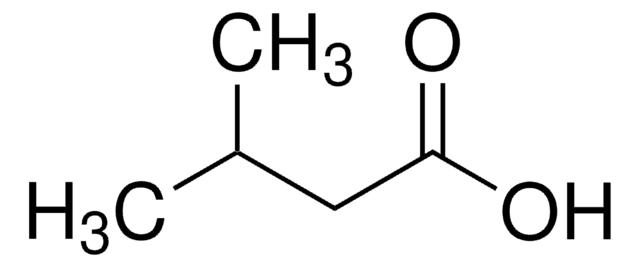推荐产品
蒸汽密度
2.55 (vs air)
品質等級
蒸汽壓力
2.4 mmHg ( 20 °C)
產品線
BioReagent
化驗
~99%
自燃溫度
955 °F
expl. lim.
12.1 %
技術
cell culture | insect: suitable
折射率
n20/D 1.386 (lit.)
bp
141 °C (lit.)
mp
−24-−23 °C (lit.)
溶解度
H2O: soluble
密度
0.99 g/mL at 25 °C (lit.)
0.993 g/mL at 25 °C (lit.)
SMILES 字串
CCC(O)=O
InChI
1S/C3H6O2/c1-2-3(4)5/h2H2,1H3,(H,4,5)
InChI 密鑰
XBDQKXXYIPTUBI-UHFFFAOYSA-N
正在寻找类似产品? 访问 产品对比指南
一般說明
丙酸(PA)是一种天然羧酸,它在纯态下是一种无色的腐蚀性液体,具有难闻的气味。它可与水混溶。工业上以羰基镍作为催化剂,通过乙烯的加氢羧化作用制备丙酸。已有研究发现PA可减少食物摄入量、降低血浆和肝脏的脂肪酸含量、改善组织胰岛素敏感性并发挥免疫抑制作用。丙酸是一种出色的原材料,因为它稳定、廉价且安全,甚至可以用作食品添加剂。
應用
用于昆虫细胞培养,抑制霉菌生长。
訊號詞
Danger
危險聲明
危險分類
Eye Dam. 1 - Flam. Liq. 3 - Skin Corr. 1B - STOT SE 3
標靶器官
Respiratory system
儲存類別代碼
3 - Flammable liquids
水污染物質分類(WGK)
WGK 1
閃點(°F)
129.2 °F - closed cup
閃點(°C)
54 °C - closed cup
個人防護裝備
Faceshields, Gloves, Goggles, type ABEK (EN14387) respirator filter
其他客户在看
Nucleophilic ?-Carbon Activation of Propionic Acid as a 3-Carbon Synthon by Carbene Organocatalysis
Jin, Zhichao, et al.
Chemistry?A European Journal, 21 (26), 9360-9363 (2015)
Flour and Breads and their Fortification in Health and Disease Prevention.
Victor R. Preedy, Ronald Ross Watson, Vinood B
Technology & Engineering, 476-476 (2011)
Biological effects of propionic acid in humans; metabolism, potential applications and underlying mechanisms
Sa'ad, H., et al.
Molecular and Cellular Biology, 1801 (11), 1175-1183 (2010)
Sa'ad H Al-Lahham et al.
Biochimica et biophysica acta, 1801(11), 1175-1183 (2010-08-10)
Undigested food is fermented in the colon by the microbiota and gives rise to various microbial metabolites. Short-chain fatty acids (SCFA), including acetic, propionic and butyric acid, are the principal metabolites produced. However, most of the literature focuses on butyrate
Eddy J Smid et al.
Current opinion in biotechnology, 24(2), 148-154 (2012-12-12)
Most known natural and industrial food fermentation processes are driven by either simple or complex communities of microorganisms. Obviously, these fermenting microbes will not only interact with the fermentable substrate but also with each other. These microbe-microbe interactions are complex
我们的科学家团队拥有各种研究领域经验,包括生命科学、材料科学、化学合成、色谱、分析及许多其他领域.
联系技术服务部门














